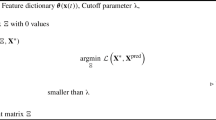Abstract
We present a new algorithm for processing the results of dynamic measurements in which it is necessary to find the input signal based on the known output or observed signal and the known transfer function of the measuring device. Previously, the authors developed a theory of optimal dynamic measurements in which methods of optimal control theory were successfully used to reconstruct dynamically distorted signals. On model examples, the first numerical algorithms of the theory of optimal dynamic measurements have shown the efficiency of the result in terms of the achieved error with a considerable computation time. The proposed numerical algorithm for solving the problem under study permits one to reduce the computation time more than fivefold. The necessary theoretical information, the general scheme of the algorithm, experimental data, and the results of processing experimental data according to the proposed algorithm are presented.








Similar content being viewed by others
REFERENCES
Granovsky, V.A., Dynamic measurements: theory and metrological support yesterday and today, Datchiki Sist., 2016, no. 3 (201), pp. 57–72.
Ruhm, K.H., Measurement plus observation—a modern structure of metrology, 21st IMEKO World Congr. Meas. Res. Ind., (Prague, 2015), article ID 116100.
Elster, C., Eichstädt, S., and Link, A., Uncertainty evaluation of dynamic measurements in line with the GUM, 19th IMEKO World Congr., 2009, vol. 1. pp. 98–101.
Sommer, K.-D., Hqnebeck, U.D., Krystek, M., et al., Modelling of dynamic measurements for uncertainty analysis by means of discretized state-space forms, 19th IMEKO World Congr., 2009, vol. 1, pp. 290–294.
Shestakov, A.L., Metody teorii avtomaticheskogo upravleniya v dinamicheskikh izmereniyakh (Methods of the Theory of Automatic Control in Dynamic Measurements), Chelyabinsk: Izd. Tsentr Yuzhno-Ural. Gos. Univ., 2013.
Shestakov, A.L., Keller, A.V., Zamyshlyaeva, A.A., Manakova, N.A., Zagrebina, S.A., and Sviridyuk, G.A., The optimal measurements theory as a new paradigm in the metrology, J. Comput. Eng. Math., 2020, vol. 7, no. 1, pp. 3–23.
Sagadeeva, M.A., Bychkov, E.V., and Tsyplenkova, O.N., The Pyt’ev–Chulichkov Method for Constructing a Measurement in the Shestakov–Sviridyuk Model, Bull. South Ural State Univ. Ser.: Math. Model. Program. Comput. Software, 2020, vol. 13, no. 4, pp. 68–82.
Shestakov, A.L., Zagrebina, S.A., Manakova, N.A., Sagadeeva, M.A., and Sviridyuk, G.A., Numerical optimal measurement algorithm under distortions caused by inertia, resonances, and sensor degradation, Autom. Remote Control, 2021, vol. 82, no. 1, pp. 41–50.
Zagrebina, S.A., On the Showalter–Sidorov problem, Russ Math., 2007, vol. 51, pp. 19–24.
Khudyakov, Yu.V., On mathematical modeling of the measurement transducers, J. Comput. Eng. Math., 2016, vol. 3, no. 3, pp. 68–73.
Belov, A.A. and Kurdyukov, A.P., Deskriptornye sistemy i zadachi upravleniya (Descriptor Systems and Control Problems), Moscow: Fizmatlit, 2015.
Zamyshlyaeva, A.A., Manakova, N.A., and Tsyplenkova, O.N., Optimal Control in Linear Sobolev Type Mathematical Models, Bull. South Ural State Univ. Ser.: Math. Model. Program. Comput. Software, 2020, vol. 13, no. 1, pp. 5–27.
Shestakov, A.L., Keller, A.V., and Nazarova, E.I., Numerical solution of the optimal measurement problem, Autom. Remote Control, 2012, vol. 73, no. 1, pp. 97–104.
Khudyakov, Yu.V., Algorithm for the numerical study of the Shestakov–Sviridyuk model of a measuring device with inertia and resonances, Mat. Zametki SVFU, 2013, vol. 20, no. 2, pp. 211–221.
Keller, A.V. and Ebel, A.A., Parallelization of numerical algorithm for optimum dynamic measurement problem solution, Proc.—2017 2nd Int. Ural Conf. Meas., 2017, vol. 2017, pp. 372–377.
Keller, A.V., On the algorithm for solving optimal and rigid control problems, Program. Produkty Sist., 2011, no. 3, p. 42.
Kotel’nikov, V.A., On the transmission capacity of ‘ether’ and wire in electric communications, Phys.–Uspekhi, 2006, vol. 49, no. 7, pp. 736–744.
Ziatdinov, S.I., Reconstruction of signal by its samples on the base of Kotelnikov counts theorem, Izv. Vyssh. Uchebn. Zaved. Priborostroenie, 2010, vol. 53, no. 5, pp. 44–47.
Funding
The study was carried out with the financial support of the Ministry of Science and Higher Education of the Russian Federation, State Order no. FENU-2020-0022.
Author information
Authors and Affiliations
Corresponding authors
Additional information
Translated by V. Potapchouck
Rights and permissions
About this article
Cite this article
Shestakov, A.L., Zamyshlyaeva, A.A., Manakova, N.A. et al. Reconstruction of a Dynamically Distorted Signal Based on the Theory of Optimal Dynamic Measurements. Autom Remote Control 82, 2143–2154 (2021). https://doi.org/10.1134/S0005117921120067
Received:
Revised:
Accepted:
Published:
Issue Date:
DOI: https://doi.org/10.1134/S0005117921120067




